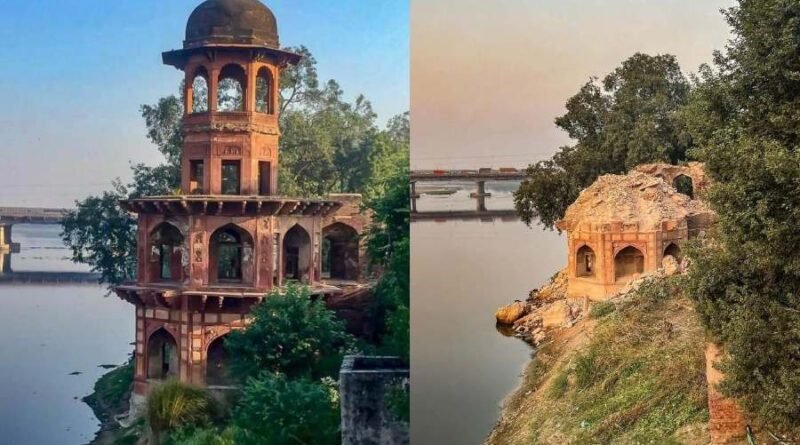Neglect cry after Mughal masterpiece crumbles: Outrage erupts over heritage site in Agra
The kiosk, once a prominent remnant of Zohra Bagh — also known as Bagh-i-Jahanara Begum — dates back to the 16th and 17th centuries
New Delhi, November 01, dmanewsdesk: The recent collapse of a three-storey Mughal kiosk on the banks of the Yamuna in Agra has drawn attention to the urgent need for conservation of lesser-known monuments.
Heritage enthusiasts have taken to social media to express their outrage over the incident.
The kiosk, once a prominent remnant of Zohra Bagh — also known as Bagh-i-Jahanara Begum — dates back to the 16th and 17th centuries. Although the area is under the protection of the Archaeological Survey of India (ASI), it has suffered from encroachments and has been partially used as a nursery.
Reports indicate that the upper floors of the kiosk collapsed over the weekend after the dome gave way.
Agra-based researcher Shantanu Jadaun shared before-and-after photos of the structure on Instagram, captioning them: “A significant portion was destroyed in the 19th century, leaving only the two corner turrets of the garden by the late 1990s. The right turret was removed during road construction in the 1990s, leaving the left turret as the only remaining part of Jahanara Bagh. It became an ‘adda’ (gathering spot) for gamblers, drug addicts and TiktoKers.
“Today, sheer negligence and incompetence have cost us this piece of heritage. The intricate red sandstone work, the perfect arches, and some of the finest chinikhana work are now lost.”
He told The Telegraph that the spot is now a popular ghat for pujas, including Chhath. “When I visited the place after the collapse I found that even the ASI signage was missing. The structure’s integrity seemed fine and locals used to use it. The ground floor is still alright.”
ASI officials in Agra stated that conservation efforts were currently under way at the Chini Ka Rauza mausoleum, with plans to restore the kiosk following its completion. Access to Zohra Bagh is through Chini Ka Rauza, and officials are committed to preserving the structure as much as possible.
The recent heavy rains in Agra have also caused damage to several monuments, including a Lodi-era mosque that collapsed in Sikandra. For the first time since the 1978 flood, the waters of the Yamuna have entered the Taj Mahal complex, resulting in reports of seepage from the dome.
Author William Dalrymple posted on X: “The ASI needs far more resources than it is given to maintain India’s magnificent heritage. The current negligence is a total embarrassment. India has vast resources. It can afford to protect its extraordinary buildings.”
The note on the garden in E. Koch and J.P. Losty’s 2017 book The Riverside Mansions and Tombs of Agra: New Evidence from a Panoramic Scroll, says: “Jahanara (1614-81) was the eldest child as well as the eldest daughter of Shah Jahan and Mumtaz Mahal, and she held a special place in her father’s affections after the death of her mother in 1631, when she became the Begum Sahiba and ran the emperor’s household.
“Her garden was one of the largest on the Agra riverfront. It was in fact begun by her mother during Jahangir’s reign and is the only foundation which can be connected to the patronage of the Lady of the Taj. The earlier construction phase can be seen in the uncusped arches of the lower two storeys of the corner towers, to which Jahanara added smaller chhatris.
“Only one of them survives and the large pavilion fronting the river has now gone, so that the scroll’s evidence is of the greatest importance in that it reveals the riverside elevation to have been an arcaded veranda consisting of three bays, each composed of a wide arch with a narrower arch on each side,” it adds.
Author Rana Safvi posted on X a page of the book with an 1830s painting of the Bagh and wrote: “Once upon a time this was one of the riverfront gardens of Agra. It belonged to Mumtaz Mahal and was inherited by Jahanara on her mother’s death. I had visited it some years ago and was appalled at its state of disrepair.”
Photographer Arko Datto photographed the structure in May this year, commissioned by the British Academy. He wrote on Facebook: “I had to walk with my tripod along a precarious crumbling bund beside the Yamuna riverbank to attain this particular perspective, and now I truly feel like that risk was worth it.”
Source: The Telegraph online



